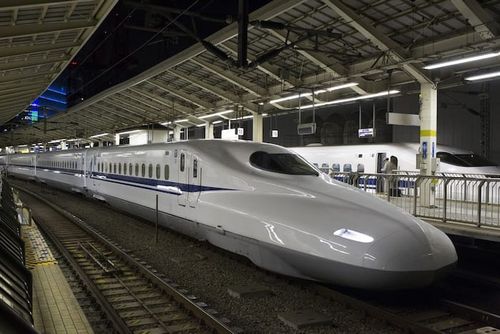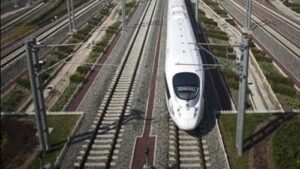The Mumbai-Ahmedabad Bullet Train project continues to advance with significant progress reported on the Gujarat segment, particularly in rail welding activities. Rail welding, a critical process for ensuring safety, durability, and passenger comfort during high-speed travel, is being conducted on the viaduct using advanced flash butt welding (FBW) technology.
The project spans approximately 508 km and is being developed by the National High-Speed Rail Corporation Ltd. (NHSRCL)
Rail Welding Progress
The process involves joining 25-meter-long rails, sourced from Japan, into seamless 200-meter-long panels. To date, 298 such panels, covering approximately 60 kilometers, have been successfully welded. Before welding, the rail ends undergo surface grinding and alignment checks to meet dimensional requirements. The FBW process is meticulously executed with rigorous testing of welds using ultrasonic and magnetic particle inspection. Any flawed welds are replaced, ensuring the highest quality standards.
Construction cost
The estimated construction cost is ₹1.1 lakh crore (approximately $15 billion), with a significant portion funded through a 50-year loan from Japan at an interest rate of 0.1%. Repayments are set to begin 15 years after the project becomes operational
The line will feature Shinkansen E5 series trains capable of reaching speeds up to 350 km/h. The majority of the rail line will be elevated, with sections in Mumbai constructed underground, including a 2 km stretch under Thane Creek. The project’s initial completion target was 2023, but delays have shifted expectations to December 2026 or potentially 2030
This transformative project, once completed, is expected to significantly reduce travel time between the two cities, enhance regional connectivity, and contribute to economic development along its route.
Specialized Japanese-sourced equipment is employed to verify alignment, and completed rail panels are transported and temporarily laid on standard gauge tracks to facilitate the movement of advanced machinery like slab-laying and CAM injection cars.
Infrastructure and Mechanization
To support these operations, NHSRCL has established Dedicated Track Construction Bases (TCBs), with four already operational between Surat-Bilimora and Vadodara-Anand. These serve as logistical hubs for handling rails, slabs, machinery, and equipment while accommodating engineers and workers.
Additionally, reinforced concrete (RC) track bed construction has commenced across Gujarat, covering locations such as Anand, Vadodara, Surat, and Navsari. So far, 64 kilometers of RC track bed have been completed.
Track Slab Production
Another integral aspect of the project is the production of track slabs. Dedicated facilities in Kim (near Surat) and Anand manufacture these using state-of-the-art technology. Over 23,000 slabs, sufficient for 118 kilometers of track, have been produced, ensuring uniformity and strength. The process includes rebar cage preparation, concrete pouring, steam curing, and strength testing.
Technological and Logistical Advancements
The Mumbai-Ahmedabad Bullet Train project underscores India’s embrace of cutting-edge infrastructure development in collaboration with Japan. The mechanized track installation employs sophisticated equipment like rail feeder cars, slab-laying machines, and flash butt welding systems, either manufactured locally under Japanese guidance or imported.
Read also New Greece-Turkey Bridge Construction to Begin: Connecting Europe and Asia

